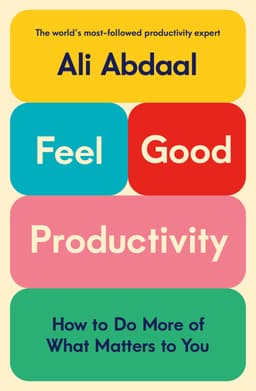
Feel Good Productivity Book Summary
How to Do More of What Matters to You
Book by Ali Abdaal
Feeling Lazy?Read 1 Minute Summary
Summary
"Feel-Good Productivity" by Ali Abdaal is a transformative guide that teaches us how to harness the power of positive emotions, overcome mental roadblocks, and achieve sustainable success by aligning our actions with our values.
Sign in to rate
Average Rating: 5
Energise
Play Is Essential For Productivity And Wellbeing
Chapter 1 emphasizes the importance of play for productivity and feeling good. The author cites examples of Nobel Prize winners who attribute their success to a playful approach. Psychologists believe play provides psychological relief and boosts creativity. Three ways to integrate play are:
- Approach work with a sense of adventure by adopting a "play personality" that matches your interests.
- Find the fun in every task by asking "What would this look like if it were fun?"
- Lower the stakes by viewing failures as data points rather than catastrophes, and approaching work with sincerity over seriousness.
Section: 1, Chapter: 1
In Frivolity There Is A Lightness Which Can Rise
"There is a difference between being serious and being sincere... In frivolity there is a lightness which can rise. But in seriousness is a gravity that falls, like a stone."
This quote by philosopher Alan Watts, cited in the book, captures the idea that we can be sincere about our work without taking it overly seriously. A playful, lighter approach allows us to find more joy and meaning.
Section: 1, Chapter: 1
The Batman Effect - Embody An Alter Ego To Boost Courage
When facing a daunting task, try embodying the persona of someone bold and confident, like a superhero.
Psychologists call this the "Batman effect". Research has shown that when children imagine themselves as superheroes while working on a difficult task, they show more self-control, focus and perseverance.
As adults, we can use the same principle. Visualize yourself adopting the posture, voice, and mentality of your courageous alter ego before taking on the challenge. Use a mantra or affirmation that represents the courage of that alter ego. This can help you overcome fear and self-doubt.
Section: 1, Chapter: 1
The Three P's - Play, Power And People Energize Us
The book presents three key "energizers" that fuel productivity by improving our mood and motivation:
- Play - Approach work playfully with a sense of adventure, finding the fun and keeping stakes low. This boosts creativity.
- Power - Build confidence, level up skills, and take ownership. Feeling empowered energizes action.
- People - Surround yourself with uplifting people who provide relational energy. Helping others also boosts energy through the "helper's high."
Integrating play, power and people into our work and life reignites the positive emotions needed to achieve more.
Section: 1, Chapter: 2
Power Comes From Within, Not From Controlling Others
Chapter 2 redefines power as personal empowerment - the sense that you are in control of your own job, life and decisions. This contrasts with the common view of power as exerting control over others.
Three ways to build personal power are:
- Boost confidence through tactics like "flipping the confidence switch" and seeing successful role models
- Level up skills by adopting a "beginner's mindset" and teaching others what you know
- Take ownership by choosing your mindset and focusing on the process even when you can't control outcomes
Section: 1, Chapter: 2
Success Doesn't Lead To Happiness
"Individuals who frequently experience positive emotions aren't just more sociable, optimistic and creative. They also accomplish more... Success doesn't lead to feeling good. Feeling good leads to success."
Abdaal cites a meta-analysis of 225 studies showing that cultivating positive emotions makes people more productive, creative and resilient at work. Feeling good provides the fuel to achieve more, reversing the common assumption that accomplishments are what bring happiness.
Section: 1, Chapter: 2
Overcommunicate Both The Good And The Bad
We often underestimate how much communication is needed to energize a team. The solution is to purposely communicate more than you think is required.
When others share good news, respond actively and constructively to celebrate the win. Recall details of their success journey. Aim to match their excitement.
For negative news, be candid without being brutally honest. Stick to objective facts about the issue and its tangible impacts. Suggest solutions or alternatives. The goal is to discuss problems constructively without downplaying harm or becoming personal.
Proactively sharing both positive and corrective information avoids leaving people in the dark, which drains energy.
Section: 1, Chapter: 3
Life Is Better With Uplifting Relationships
Early in Brian Eno's music career, a chance encounter with saxophonist Andy Mackay connected him to London's vibrant glam rock scene in the 1970s. Immersed in this community, Eno collaborated with other innovative musicians exploring new artistic frontiers.
This led him to form the influential band Roxy Music and become a pioneering producer, working with groundbreaking artists. Being part of a talented "scenius" pushed Eno to do his most creative work.
The book presents this as an example of how surrounding yourself with uplifting, inspiring people provides relational energy that fuels productivity and success. The collective "scenius" matters more than individual genius.
Section: 1, Chapter: 3
Unblock
Unblock Productivity By Addressing Emotional Barriers
Part 2 of the book focuses on overcoming procrastination by tackling the emotional blockers that make us feel bad and achieve less. The three main blockers are:
- Uncertainty - Lacking clarity on why, what or when to do a task
- Fear - Anxiety about failure, judgment or not being good enough
- Inertia - Difficulty getting started and maintaining momentum
The "unblock method" aims to identify and eliminate these negative emotions at the root, rather than just treating procrastination symptoms with motivation or discipline. Each blocker is addressed in the subsequent chapters.
Section: 2, Chapter: 4
Use Commander's Intent To Give Tasks A Clear Purpose
Chapter 4 tackles procrastination from uncertainty by seeking clarity on tasks. One tool is "Commander's Intent," a military concept of conveying the core purpose of a mission:
- The Purpose - The "why" behind the task
- The End State - The ultimate goal or vision
- Key Tasks - General steps to achieve the objective
By defining the intent behind a task, you provide flexible direction without micromanaging details. This aligns teams around a meaningful goal while empowering adaptation.
Personally apply Commander's Intent by clarifying the core purpose before starting any project. Let that guide your planning and execution.
Section: 2, Chapter: 4
Define NICE Goals To Make Progress Feel Good
Many popular goal-setting frameworks focus on crafting Specific, Measurable, Attainable, Relevant, and Time-bound (SMART) goals. However, research suggests overly narrow, outcome-oriented goals can undermine motivation. The book proposes an alternative:
- Near-term - Focus on short timeframes to avoid being overwhelmed
- Input-based - Emphasize the process and effort over end results
- Controllable - Aim for targets within your influence
- Energizing - Structure goals around what makes the journey enticing
NICE goals define a clear next step while keeping the emphasis on making progress rewarding.
Section: 2, Chapter: 4
Courage Is Found By Knowing, Facing And Reframing Fear
Chapter 5 addresses fear as a cause of procrastination and low productivity. Three steps help build courage:
- Know your fear. Label anxieties to strip them of power. Explore their roots.
- Reduce fear's hold. Put worries in perspective using the 10/10/10 rule - will it matter in 10 minutes, 10 months, 10 years? Build confidence by focusing on the process over outcomes.
- Overcome paralysis. Recognize most people are focused on themselves, not judging you. Embody a confident alter ego to access inner courage.
While fear may never vanish entirely, using these tools allows you to take action despite it. Moving from fear to courage restores productivity.
Section: 2, Chapter: 5
The Spotlight Effect Makes Us Overestimate How Much Others Notice Us
At a dinner party hosted by his friend Jake, the author made a joke that fell completely flat. He felt mortified, worrying he had offended Jake and alienated the whole group. He catastrophized it would cost him all his friends.
Later, he shared his social anxiety with another guest, who didn't even recall him making a joke. She had been too busy enjoying Jake's surprisingly good cooking to notice.
This illustrates the "spotlight effect" - our tendency to vastly overestimate how much others pay attention to our missteps. In reality, most people are too focused on themselves to scrutinize us intensely. Reminding yourself that "no one cares" as much as you imagine can liberate you to take social risks.
Section: 2, Chapter: 5
Engineer Your Environment To Make Starting Easier
Chapter 6 covers overcoming procrastination from inertia - the tendency to keep doing nothing when you're already idle. One solution is reducing friction in your surroundings.
Friction includes physical barriers, like keeping your guitar tucked out of sight, and emotional resistance, like dreading a tedious chore. Both make it harder to get started.
To reduce friction and build momentum:
- Organize your space to make key tools visible and accessible
- Break daunting projects down into 5-minute chunks
- Find the path of least resistance to just begin
Progress, not perfection, is the goal.
Section: 2, Chapter: 6
Create An Accountability Cascade To Maintain Momentum
Inertia makes it difficult to maintain progress after a motivated beginning. Accountability creates valuable structure to keep moving.
Build accountability with an "accountability cascade":
- Public commitment - Share your intent with others to add social stakes
- Accountability partner - Pair up with someone to check in on each other's progress regularly
- Reward/penalties - Build in consequences for following through or falling short
- Tracking - Monitor your progress visibly to stay on course
Start with a single accountability partner, then gradually expand to a full cascade. Customizing it to your needs and preferences will make it an energizing support rather than a stressful burden.
Section: 2, Chapter: 6
Sustain
Protect Your Energy To Prevent Burnout
Part 3 focuses on sustaining productivity for the long-term by avoiding burnout. Burnout stems from three key issues:
- Overexertion - Taking on too much without breaks, leading to fatigue
- Depletion - Not renewing energy through quality rest and recovery
- Misalignment - A mismatch between daily actions and core values
The three "sustainers" to protect energy and align efforts are:
- Conserve - Do less to make what you do more impactful
- Recharge - Engage in creative, natural and mindful restoration
- Align - Connect short-term decisions to long-term meaning
Section: 3, Chapter: 7
Do Less To Achieve More, Like Lebron James
NBA superstar LeBron James illustrates the power of conserving energy. Despite being one of the fastest players, he spends over 70% of his time on the court walking or resting. By not sprinting constantly, LeBron conserves his energy for explosive plays.
Emulating this, we can consciously limit our efforts to what's essential. Doing less of what's unnecessary allows us to bring our best to what matters. Abdaal suggests three ways:
- Overcome overcommitment by being selective
- Resist distraction to maintain focus
- Prioritize breaks and renewal
Section: 3, Chapter: 7
Saying No Is Saying Yes To What Matters
"People think focus means saying yes to the thing you've got to focus on. But that's not what it means at all. It means saying no to the hundred other good ideas that there are. You have to pick carefully." - Steve Jobs
The book cites Jobs' perspective that innovation requires declining many good options to focus on the vital few. As Apple CEO, Jobs famously said no to 1000 promising projects to pour resources into revolutionary products like the iPhone.
Section: 3, Chapter: 7
Use The CALM Framework For Restorative Hobbies
Not all leisure combats burnout equally. Chapter 8 shares the CALM framework for recharging hobbies:
- Competence - Builds skills and abilities over time
- Autonomy - Provides freedom to make independent choices
- Liberation - Offers mental distance from daily stresses
- Mellow - Has a relaxed, low-stakes atmosphere
Engaging in hobbies with these features, like learning an instrument or craft, restores energy more than passive consumption. The key is pursuing them consistently as a practice, not sporadically or with a perfectionist mindset.
Reflect on your hobbies and assess them against the CALM criteria. Adjust or adopt new leisure pursuits accordingly.
Section: 3, Chapter: 8
Savor Unstructured Time To Unleash Creativity
While scheduled renewal like walks or naps help sustain energy, unstructured downtime is equally vital for recharging.
When our minds wander freely, the brain's default mode network activates. This neural circuit enables reflection, imagination and problem-solving.
Build unstructured time into your life with tactics like:
- "Untouchable days" free from meetings or calls
- Making chores or errands "device-free"
- Preserving weekends or evenings for open-ended activities
When you hit a wall, resist forcing a solution. Step back and let your mind meander. The answer often arrives through a creative detour.
Section: 3, Chapter: 8
Align With Your Values To Find Enduring Motivation
Chapter 9 confronts misalignment burnout - the drain of investing effort in unfulfilling pursuits. Aligning actions with personal values creates motivation that lasts.
Three tools help connect daily decisions to core values:
- Long-term - Envision your ideal future and define "success" on your terms. What would make your future self proud?
- Medium-term - Set 12-month goals anchored in your values. Make value-aligned choices each week to progress.
- Short-term - Link each day's key actions to your goals. Start small and build momentum.
When values and actions align, each choice adds meaning. Progress becomes more energizing than perfectionism.
Section: 3, Chapter: 9
Test Your Way To An Authentic Path With Experiments
Finding enduring motivation is a continuous process. Our needs and values shift with time and experience.
Rather than committing to one rigid path, run "alignment experiments." These are small tests to evaluate what resonates and what doesn't.
For any role or routine that feels draining:
- Define the gap - What specific part feels misaligned?
- Form a hypothesis - What change might improve fulfillment?
- Run a trial - Test the new approach for a defined period.
- Evaluate fit - Assess the results and iterate as needed.
Small bets uncover what aligns without the pressure to overhaul everything at once. Stay curious, and adapt as you discover what matters.
Section: 3, Chapter: 9
Related Content
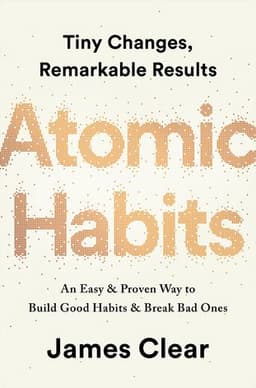
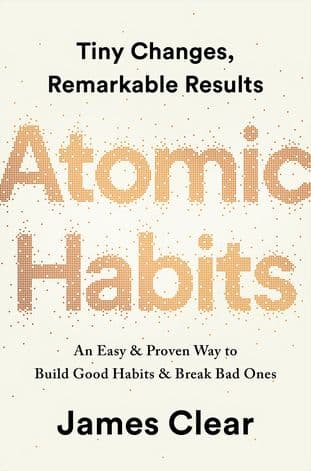
Atomic Habits Book Summary
James Clear
Atomic Habits reveals the surprising power of small habits, demonstrating how tiny changes can compound into remarkable results over time. By focusing on systems over goals and building identity-based habits, you can create lasting change and unlock your full potential.
Atomic Habits reveals the surprising power of small habits, demonstrating how tiny changes can compound into remarkable results over time. By focusing on systems over goals and building identity-based habits, you can create lasting change and unlock your full potential.
Productivity
Personal Development
Psychology
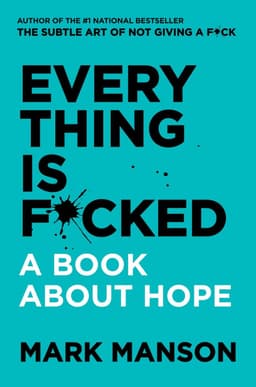
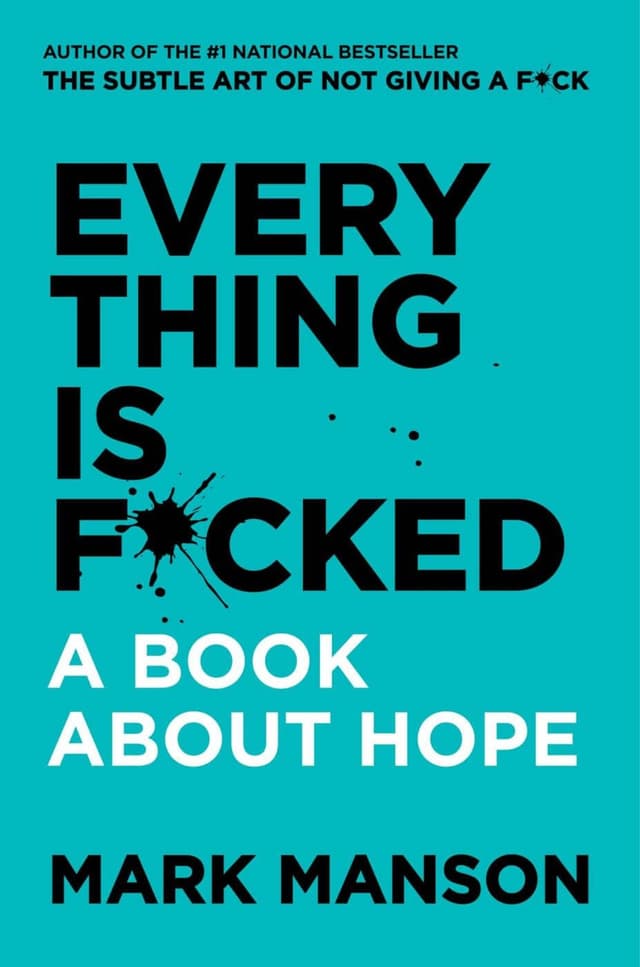
Everything is F*cked Book Summary
Mark Manson
In a world where everything seems fcked, Manson provides a provocative exploration of the human condition, offering a counterintuitive perspective on the nature of hope, the illusion of self-control, and the quest for meaning amongst uncertainty
In a world where everything seems fcked, Manson provides a provocative exploration of the human condition, offering a counterintuitive perspective on the nature of hope, the illusion of self-control, and the quest for meaning amongst uncertainty
Personal Development
Philosophy

